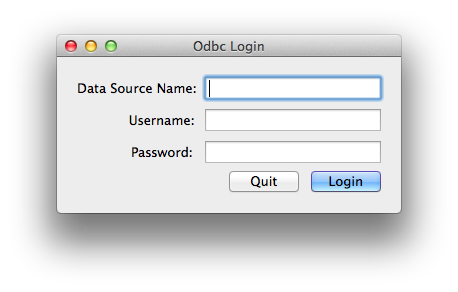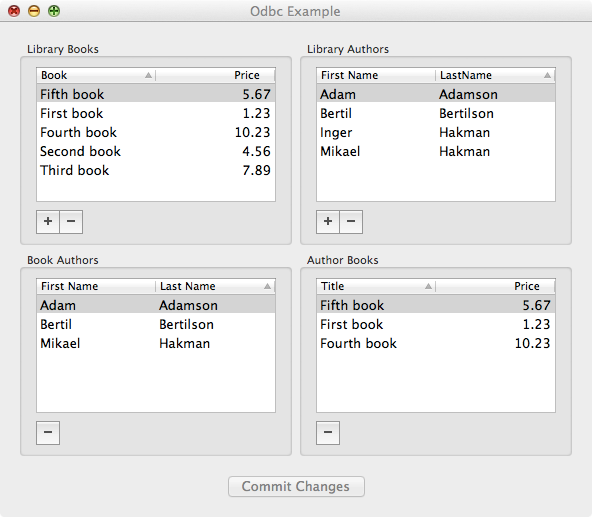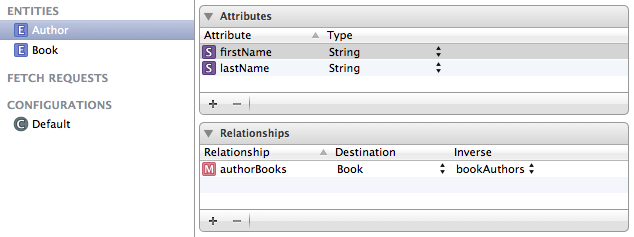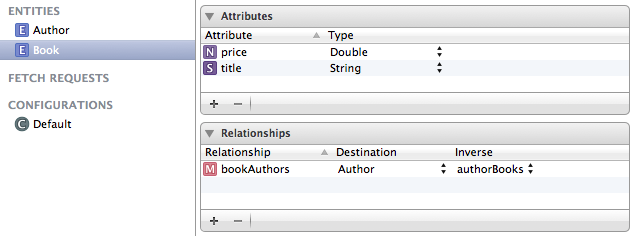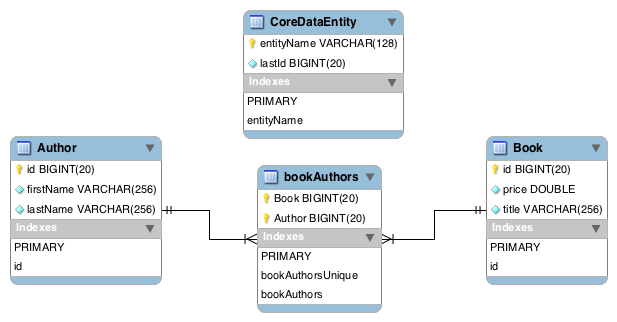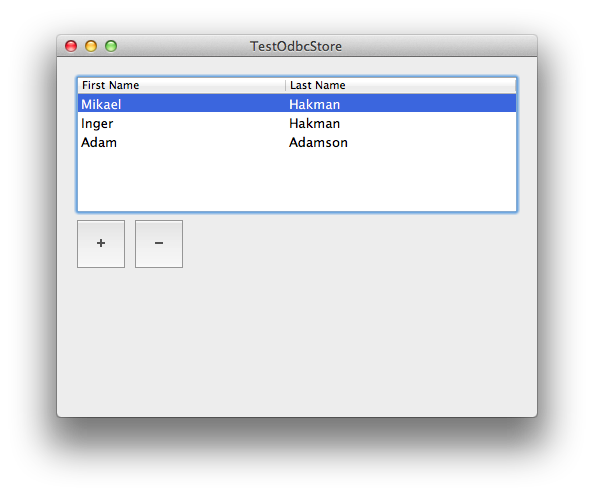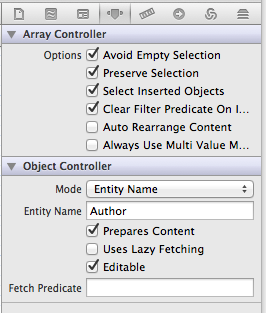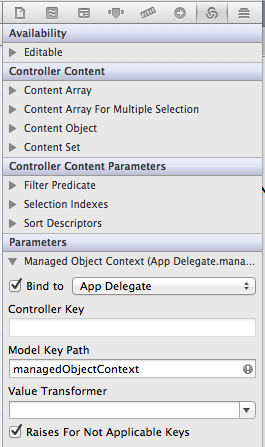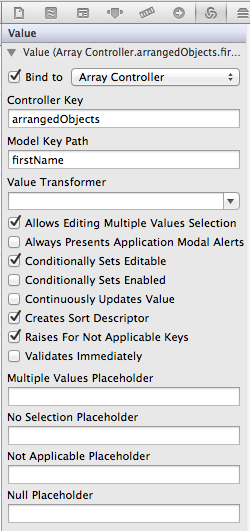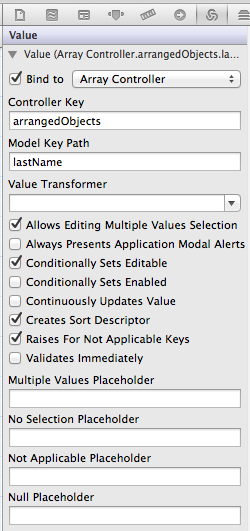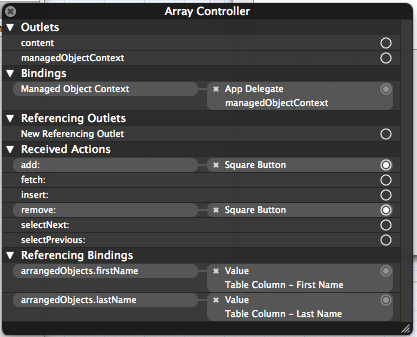#Odbc framework users guide#
Odbc framework is Cocoa framework providing access to ODBC databases. It works on top of iODBC framework which is a low level C-oriented framework of ODBC routines that follow ODBC specification. The framework includes also an experimental Cocoa Core Data Persistent Store for Odbc. It has been tested with IBM DB2, Mimer SQL, MySQL, Oracle, PostgreSQL and SQLite.
ODBC framework consists of a number of classes. Currently only OdbcConnection, OdbcStatement, and OdbcException are used in non-Core Data applications. OdbcStore class and OdbcAppDelegate class are used in Core Data applications. The rest is for internal framework use.
In order to use Odbc framework you don't need to know ODBC specification. You do need to know some basics of SQL, relational databases and of course Objective-C.
The documentation consists of:
- This user guide document
- Odbc framework overview page
- Class hierarchy page
- Invidual pages for each class
#Example console application#
The following is a simple Cocoa console (non-GUI) application that uses Odbc framework.
// main.m
#import <Cocoa/Cocoa.h>
#import <Odbc/Odbc.h>
int main (int argc, char * argv []) {
OdbcConnection * connection = [OdbcConnection new];
[connection connect: @"testdb" username: @"sysadm" password: @"secret"];
OdbcStatement * stmt = [connection newStatment];
[stmt execDirect: @"select * from book order by title"];
while ([stmt fetch]) {
long bookId = [stmt getLongByName: @"bookId"];
NSString * title = [stmt getStringByName: @"title"];
double price = [stmt getDoubleByName: @"price"];
NSLog (@"%ld %@ %f",bookId,title,price);
}
[stmt closeCursor];
return 0;
}
In this application we first create an OdbcConnection and then use it to connect to ODBC data source named 'testdb' with username 'sysadm' and passwaord 'secret'. You should replace 'testdb', 'sysadm', 'secret' with your own names used in your own database. Then we create a new OdbcStatement. We use this statement to execute SQl query 'select * from book order by title'. After that we go into a loop fetching a new row each time aroud. We get 'bookId', 'title' and 'price'. Then we write the data to the console. When the loop terminates we close the statement.
#Prerequisites#
OS X version 10.9.1 or latter is requred. XCode vesion 5.0.2 or latter is also required. Futhermore, you need iODBC framework version 3.52 or latter. You also need a database manager running on your workstation or on a network server. And of course you need the software described here (Odbc framework).
As of this writting, Mac OS X version 10.9.1 is available from Apple AppStore without charge. Before updating you should check/repair your hard drive for errors. You can do this by booting your Mac in rescue mode.
Then you need XCode version 5.0.2 or latter installed on your Mac. If you don't have it go to Apple AppStore, download and install it. It's free of charge. Test your installation by writting and running a small application.
Next you need iODBC framework version 3.52 or latter. Download it from http://www.iodbc.org Download the Mac OS X dmg-file and install it on your Mac. Do not use the source distribution because it makes it easy to install files in wrong location.
Furthermore you need a database manager, either standalone on your Mac, or on accessible network server. If you don't have it, you need to download and install it. See Notes at the end of this document for notes about various database managers that Odbc framework has been tested with.
Our developer team uses primarily Mimer SQL and MySQL. Mimer SQL is first-class, fully-fledged, commercial grade relational database management system that is free of charge for development purposes. A more direct reason for selecting Mimer SQL is its concurrency control. Mimer SQL uses optimistic concurrency control, which means that there is no risk for two or more applications to lock out each other. Database managers that use locking concurrency control may result in one application waiting for another. Mimer SQL can be downloaded from http://developer.mimer.com On the same site there is an article "Using Mimer SQL with iODBC on Mac OS X". You can find it under "How to" heading on the left. It describes how to install and use Mimer SQL with iODBC on Mac OS X.
The iODBC framework mensioned above installs an application called "iODBC Administrator". Run iODBC Administrator and verify that your database ODBC driver is registered under "ODBC Drivers" tab. If not then register your database ODBC driver. Using "System DSN" tab register a DSN (Data Source Name) that you want to use. It will often be the database or server that you installed/started when you installed your database.
Now install this software either by using Git clone command or downloading zip-file. If you downloaded zip-file then unpack it into a directory. Both ways result in Xcode project directory.
#Building the software#
This repository contains XCode project with 6 targets:
- Odbc - builds the framework itself
- LoginServer - builds the LoginServer
- TestConnect - tests connection to an ODBC data source
- OdbcExample - builds Cocoa Core Data application using Odbc
- OdbcDocumentation - generates the documentation
- OdbcTests - performs unit tests of the framework
If you are going to build some targets, build them in the above order. However you don't need to build anything if you only will use the framework and documentation. Simply copy file 'Odbc.framework' from project directory to /System/Library/Frameworks. Use Finder, first to delete any old Odbc.framework versions, and then Copy/Paste the new version. Documentation is included in 'html' directory in the project directory.
You can use this project to build and run Odbc framework software. If you want to build then build at least "Odbc", "LoginServer", and "OdbcExample". Run "Odbc Example". If everything works ok then OdbcExample shows a login window:
Enter your DSN, username, and password. If these are correct then the folowing window is shown:
#Description Cocoa Core Data example#
The example shown above uses the following Core Data model:
The model consists of two entities and two relationships. Entity Book has attributes 'price' and 'title'. Entity Author has attributes 'firstName' and 'lastName'. The double-headed arrow between the entities represents the two relationships. One relationship from entity Book to entity Author is called 'bookAuthors' (name not shown in picture above) and the second relationship from entity Author to entity Book is called 'authorBooks' (name not shown). Both are one-to-many relationsips. In plain words, each book can be written by a number of authors and each author may have written a number of books.
The nice picture above was generated by XCode Core Data model editor based on the following information entered by application developer:
When the example application is run for the first time against a particular ODBC data source it will generate the following schema in the database:
There are 4 tables in the schema above. Table 'CoreDataEntity' is needed is every ODBC Core Data application. It keeps track of primary keys used in the other tables. For each Core Data entity a table is generated containing column 'id' as primary key. The other columns correspond to entity attributes. Example application uses 'Author' and 'Book'. Each pair of entity relationships results in one table. Example application uses 'authorBooks' and 'bookAuthors' pair of relationships. This results in table 'bookAuthors' with columns 'Book' and 'Author'. This table has also foreign keys constraints to both 'Autor' and 'Book' tables.
The name of ODBC data source, username, and password to use are specified by an URL. This URL may be generated by using method 'loginUrl' which displays a login dialog and verifies the infomation by connecting to and disconnecting from the database.
You find the following method in 'AppDelegate' class:
- (NSURL *) persistentStoreUrl {
return self.loginUrl;
}
A lot of code in 'AppDelegate' has been generated by XCode when you specify 'Core Data' for a new project. This code has been included in class OdbcAppDelegate so that you only need to inherit your AppDelegate from that. The other classes in the application has been written by me in order to control the UI (mostly drag and drop). Most of work has been done in XCode Interface Builder.
Example application displays the following UI to the user:
Table 'Library Books' displays books in the library. You add/remove books by coresponding +/- buttons under the table. Table 'Library Authors' displays authors in the library. You add/remove authors by corresponding +/- buttons under the table. Table 'Book Authors' displays authors of the selected book. You add book author by dragging an author from 'Library Authors" to 'Book Authors'. Table 'Author Books' displays books for the selected author. You can drag a book from 'Library Books' into 'Author Books' to add the book to the selected author. When running the application for the first time against a particular data source the tables will be empty.
#Unit tests#
When run the unit tests it asks (on the console) for data source name, username, and password. If the information is invalid then an error message is shown and no tests are performed.
The tests will create tables named 'BOOK', 'AUTHOR', 'BOOKAUTHORS' 'COREDATAENTITY', and 'TESTTAB' in the data source. The tables should be removed after the tests. In the database you should create a special user for running the tests.
In order to build, test and run this software you can follow the list below:
- Upgrade Mac OS X to at least version 10.9.1 using AppStore. It is free of charge.
- Upgrade or install XCode at least version 5.0.2 using AppStore. It is free of charge.
- Download and install iODBC framework at least version 3.52 from http://www.iodbc.org. It is free of charge.
- If you want to use Git then dowload and install it from http://git-scm.com. It is free of charge.
- Clone (using Git) or unpack (not using Git) this repository into an empty directory. This will result in an XCode project directory. It is free of charge.
- Now you should be able to open the project in XCode and build the targets.
- Dowload a database manager with ODBC driver and client tools.
- Use client tools to create a database.
- Use the 'iODBC Administrator' to register your ODBC connector and to create an ODBC data source.
- Now you shoud be able to run the unit tests and example application.
In this section I will guide you in creating a new XCode project using Persistent Store for ODBC. The section contains the following topics:
- [Creating new project](#Creating new project).
- [Adding required frameworks](#Adding required frameworks).
- [Modifying AppDelegate](#Modifying AppDelegate).
- [Creating new data model](#Creating new data model).
- [Adding NSArrayController](#Adding NSArrayController).
- [Adding NSTableView](#Adding NSTableView).
- [Adding buttons](#Adding buttons).
Create new XCode project of type 'Application/Cocoa Application'. Uncheck 'Use Core Data' checkbox. If you check it then it will generate a lot of code in your AppDelegate. This code is already contained in Odbc.framework and therefore we do not want to generate it.
Build and run your new application. It should build without errors and warnings. It should run without problems. Quit the application.
Copy Odbc.framework from Odbc project directory to either /System/Library/Frameworks or to your project directory. Copying to /System/library/Frameworks makes things a lttle easier and you will have the framework in right place for other projects.
Select 'Frameworks' in your project Project Navigator. Add file Odbc.framework . Uncheck 'Copy items to destination...' checkbox. You find the files in either your project directory or in '/System/Library/frameworks/ depending where you copied them.
Select 'Frameworks' in your Project Navigator. Add file 'CoreData.framework' from /System/Library/Frameworks. Uncheck 'Copy items to destination...'.
If you copied Odbc.framework to your project directory then you need to modify your project settings. If you copied the framework to /System/Library/Frameworks/ then you don't need to do the following. Select your project in Project Navigator. You should see the Project Editor now. Select your project in Project Editor. Select 'Build Settings' tab. Find 'Run Search Path' in the build settings area. Select 'Run Search Path", click on the settings row and enter $(PROJECT_DIR). Press Enter.
Build and run your application. There shouldn't be any problems. Quit your application.
Modify your AppDelegate.h. Add the following line to imports directives:
#import <Odbc/Odbc.h>
Modify the @interface statement to read:
@interface AppDelegate : OdbcAppDelegate <NSApplicationDelegate>
Your AppDelegate.h should now look like the following:
#import <Cocoa/Cocoa.h>
#import <Odbc/Odbc.h>
@interface AppDelegate : OdbcAppDelegate <NSApplicationDelegate>
@property (assign) IBOutlet NSWindow * window;
@end
Modify your AppDelegate.m. Change the 'applicationDidFinishLaunching' method:
- (void) applicationDidFinishLaunching : (NSNotification *) notification {
[super applicationDidFinishLaunching : notification];
}
Method 'applicationDidFinishLaunching' is invoked by Cocoa when the application is ready to run (all the windows has been created etc.). The expression:
[super applicationDidFinishLaunching : notification];
calls the corresponding method in the superclass (OdbcAppDelegate).
Add also the following method:
- (NSURL *) persistentStoreUrl {
return self.loginUrl;
}
The method 'loginUrl' displays login dialog box. It lets the user to specify data source name, username, and password. Then it verifies the information by trying to connect to and disconnect from the database. If everything goes ok then it returns the required url.
Your AppDelegate.m should now look like the followig:
#import "AppDelegate.h"
@implementation AppDelegate
- (void) applicationDidFinishLaunching : (NSNotification *) notification {
[super applicationDidFinishLaunching : notification];
}
- (NSURL *) persistentStoreUrl {
return self.loginUrl;
}
@end
Build and run your application. There shouldn't be any problems. Quit the application. The login dialog box will not be shown because it is not requred yet.
The above is all the Objective-C code we need to write. Rest of the work will be done using XCode Model Editor and Xcode Interface Builder.
In this section we will create a data model for your application.
Select your application folder in the Project Navigator, right or control click on it. Select 'New File...' on the popup menu. Select 'Core Data'/'Data Model' on the dialog. Press 'Next' button. On the 'Save As' dialog specify name of the model. To keep things easy specify the same name as your application. Press 'Create' button.
Build and run your application. It shouldn't be any problems. Quit the application.
Now your are set up and can continue to build your application as any other Core Data application. However if you don't know Core Data very well then you may follow the guide below. We will create an application that does something real. The application will display a list of authors from the database and let the user add, modify, and delete authors.
Select your model file (extension .xcdatamodeld) in the Project Navigator. You should see Model Editor now. Press 'Add Entity' button. Specifiy entity name 'Author' in Data Model Inspector. Press Enter. Add attribute 'firstName' of type string, non optional. Add attribute 'lastName' of type String, non aptional.
Now we have a simple data model with entity 'Author' with two attributes 'firstName' and 'lastName'. In model editor this looks like the following:
Build and run your application. There shouldn't be any problems. Quit the application.
Now we will continue the work in XCode Interface Builder. Select the 'MainMenu.xib' file in the Project Navigator. You should see the Interface Builer UI. We will build the following UI:
Add an Array Controller to the list of objects contained within the xib file. Select the new 'Array Controller' object. In the Inspector pane select 'Attributes Inspector'. Specify 'Entity Name' in the 'Mode' field. Specify 'Author' in the 'Entity Name' field, press Enter. Check the 'Prepare Content' checkbox. The Attributes Inspector should look as following:
Select Bindings Inspector in the Inspector pane. Find 'Parameters' heading. Find 'Managed Object Context' and expand it. Check the 'Bind to' checkbox and choose 'App Delegate' in the drop down box. Specify 'managedObjectContext' in 'Model Key Path' field. The Bindings Inspector should look as following:
Build and run your application. There shouldn't be any problems. The application should display a login dialog. Fill in the required information and press 'Login' button. If the information was correct then applcation window is shown. Otherwise an error dialog is shown. Quit the application.
Still in the Interface Builder add a Table View to your view.
Select Table Header. Click on it two or three times until it goes gray/white. Now adjust the table columns widths to be approximately equal.
Select the first table column. In Attributes Inspector set Title to 'First Name', press Enter. In Bindings Inspector heading Value check 'Bind to' check box, select 'Array Controller' in the drop down list, Controller Key should be 'arrangedObjects' and Model Key Path set to 'firstName'. Press Enter. This is depicted below:
Select second table column. In Attributes Inspector set Title to 'Last Name', press Enter. In Bindings Inspector heading Value check 'Bind to' check box, select 'Array Controller' in the drop down list, Controller Key should be 'arrangedObjects' and Model Key Path set to 'lastName'. Press Enter. This is depicted below:
Build and run your application. There shouldn't be any problems. It should present a nice table with two columns named 'First Name' and 'Last Name'. It still lacks means to enter the data. Quit the application.
Still in Interface Builder.
Add Square Button to the view. In Attributes Inspector find 'Image' drop down list. Select 'NSAddTemplate'. Control-click (or use right mouse button) on the button in the view and drag to 'Array Controller' object. Drop there and select 'add:' on the popup menu.
Add another Square Button to the view. In Attributes Inspector find 'Image' drop down list. Select 'NSRemoveTemplate'. Control-click (or use right mouse button) on the button in the view and drag to 'Array Controller' object. Drop there and select 'remove:' on the popup menu.
Control-click (or right-click) on the Array Controller. You should obtain the following popup:
Build and run the application. It should display a window like following:
When you run your application for the first time, the table will be empty. You can add an author using + button. You can remove an author using - button. You can modify an author by double-clicking on it. Your changes will automatically be saved to the database when you quit the application.
The 'Test' button in iODBC Administrator does not allways work. Sometimes you get errors and yet everything is allright. Use the TestConnectApp application provided in this software.
The iODBC Administrator writes sometimes wrong path names to odbc.ini and odbcinst.ini in /Library/ODBC directory. Use TextEdit to read the files and correct any mistakes.
The installation of DB2 on OS X is not what you expect on a Mac. It is more Unix oriented, no GUI, you work in a terminal window. It works if you follow instructions on https://www.ibm.com/developerworks/community/forums/html/topic?id=77777777-0000-0000-0000-000014927797
After installation you create a database using DB2 command.
ODBC driver for DB2 and OS X is available from OpenLink.
Mimer SQL can be dowloaded from http://developer.mimer.com/downloads/index.htm.
ODBC driver and client tools are included in Mimer SQL for OS X.
After installation you should create a databank using Mimer Batch SQL utility.
Download and install MySQL, MySQLWorkbench and MySQL ODBC driver.
After installation you create a database using SQLWorkbench.
ODBC driver is available from MySQL.
Currently, Oracle is not avaiable on OS X. However, there is an Oracle ODBC driver for OS X available from OpenLink. You can use it and run with Oracle running on a server.
The official ODBC driver for PostgreSQL can be downloaded and installed by the Application Stack Builder tool provided in the main PostgreSQL installation. This driver needs a file named 'libltdl.7.dylib' in /usr/local/lib directory. If you, like me, doesn't have it then yo need to install it by the following procedure.
Install command named 'brew' from http://brew.sh. Look at the end of the page for command needed to install it. Run the command in a terminal window. Then still in terminal window perform commands:
brew install libtool --universal
brew link libtool
Now, the required file should be in place.
Also, ProgreSQL needs a special option in odbc.ini file in /Library/ODBC directory. The following option should be added to odbc.ini for each database using ProgreSQL:
UseServerSidePrepare = 1
You can use iOdbc Administrator to enter this option or you can use TextEdit to manually edit the odbc.ini file.
ODBC driver for PostgeSQL and OS X is available from PostgreSQL.
